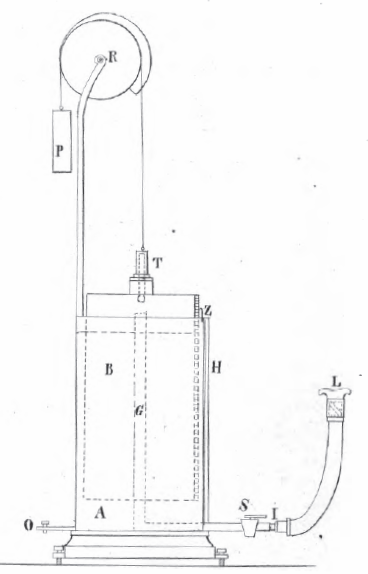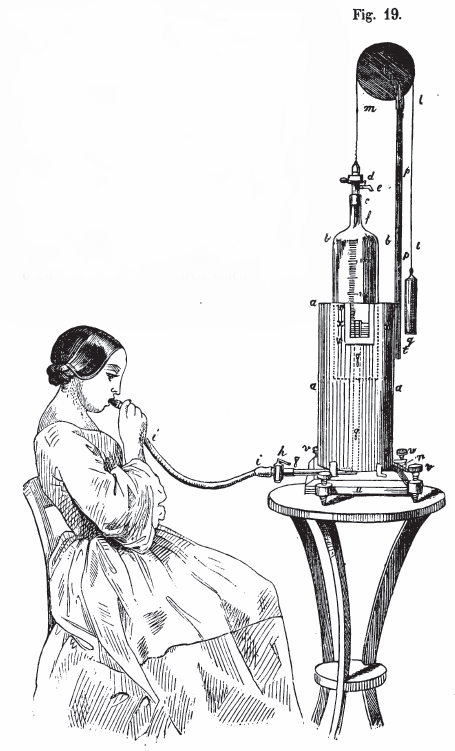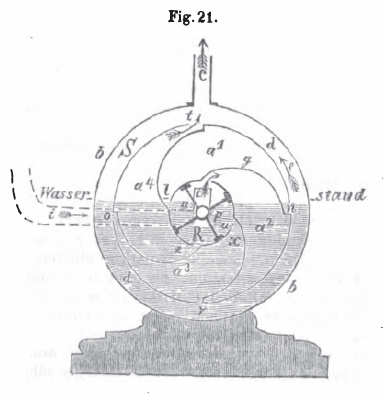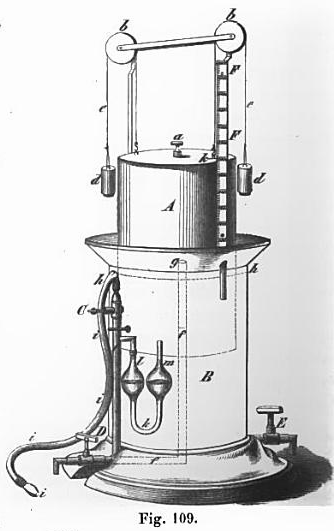In 1846 John Hutchinson published his treatise “On the capacity of the lungs and on the respiratory functions”. His spirometer design was based on the gasometer, originally invented by Antoine Lavoisier then popularized and commercialized by James Watt in the 1790’s. Hutchinson turned the gasometer into a precision scientific instrument. Just as importantly, his observations on the relationship between the vital capacity and an individual’s gender, height and age galvanized many other researchers.
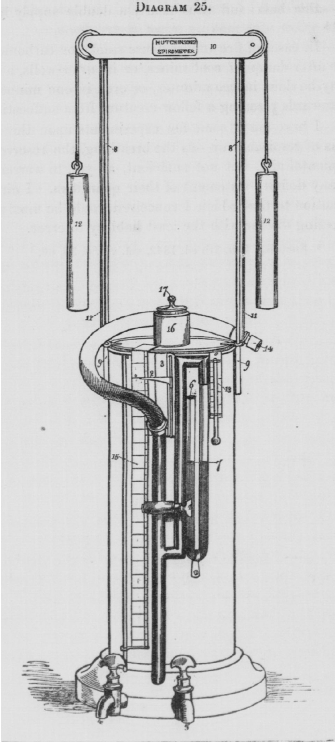
The first scientific spirometer, published in 1846. The first drawing of the Hutchinson Spirometer from Hutchinson J. On the capacity of the lungs and on the respiratory functions, with a view of establishing a precise and easy method of detecting disease by the spirometer. Med Chir Trans 1846; 29: 137-252.
Hutchinson was well aware the effect that pressure and temperature have on air volume. On the side of the spirometer there is a U-tube manometer that was used to ensure the interior pressure was at ambient, and a thermometer. After an exhalation into the spirometer a petcock was closed, giving time for the pressure and temperature to equilibrate before the volume was recorded.
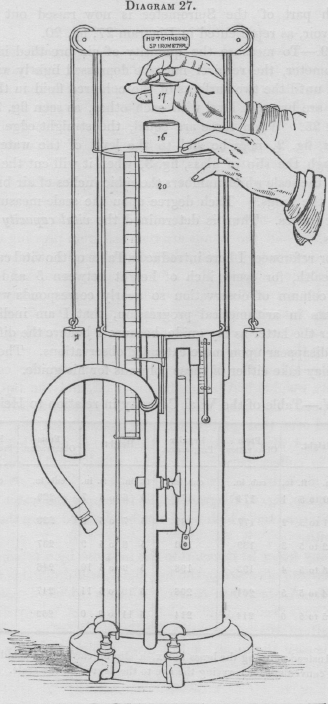
The second drawing of the Hutchinson Spirometer, published in 1846. From Hutchinson J. On the capacity of the lungs and on the respiratory functions, with a view of establishing a precise and easy method of detecting disease by the spirometer. Med Chir Trans 1846; 29: 137-252.
To ready the spirometer for another test a cork on the top of the bell was removed (as shown in this illustration) and the bell returned to its starting position.
An updated design of the Hutchinson spirometer, from 1848. From: Über die Menge der ausgeathmeten Luft bei verschiedenen Menschen und ihre Messung durch das Spirometer: ein Beitrag zur medicinischen Diagnostik : mit 1 Abbildung by Gustav Simon and Julius Vogel, 1848, endplate. Spirometer manufacturer unknown.
Spirometer design attributed to Simon Vogel, 1850. From: Die Erkenntniß der Krankheiten der Brustorgane aus physikalischen Zeiche n oder Auscultation, Percussion und Spirometrie: Nach Heribert Davie’s Vorlesungen u. eigenen Beobachtungen by Johann Friedrich Hermann Albers, 1850. Endplate.
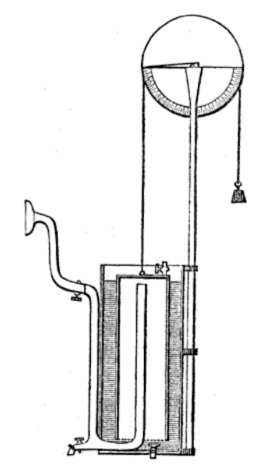
McKuen’s Spirometer, 1851. From “The Medical Examiner, and Record of Medical Science”, Volume 7, Issues 1-4, published by Lindsay & Blakiston, 1851, page 51.
“Another contribution from the domain of physics has been made, by Mr. Hutchinson, to the investigation of the respiratory functions in health and disease. It consists in an instrument he has invented, by which may be measured the amount of air that may be taken into and expelled from the lungs by voluntary effort; or what he calls “the vital capacity” of the lungs. By this instrument Mr. Hutchinson believes that incipient disease may be detected before physical signs exist. This instrument he names spirometer.
“On the table is an instrument of the kind. It is simple and less expensive than that of Mr. Hutchinson. It was planned by a gentleman of this city, Mr. Charles McKuen, who has been confined to his room for some months by a pulmonary affection; possessing an active mind, with a turn for philosophical pursuits, he occupies his time in scientific observations and investigations. I gave him Mr. Hutchinson’s paper, published in the Medico-Chirugical Transactions, containing a diagram of his instrument. Mr. McKuen constructed the instrument now before you on the same principles. I think it preferable to the original.
“The instrument will be seen to consist of a cylinder containing water, in which immersed is another cylinder inverted, into which the expired air finds its way. This cylinder is counterpoised by a weight attached to a cord passing over a wheel of large diameter, and which rotates with the ascent of the cylinder, caused by the entrance of expired air, and on which a scale indicates the amount that has be introduced.
“The person using this instrument must first loosen and part of his dress that may restrain the movements of the chest or abdomen. He then deliberately expands his chest to its greatest extent, and expires through the mouthpiece and air tube into the cylinder. As this rises the wheel turns round, and an index marks on the scale, in inches, the amount expired.”
Wintrich Spirometer, 1854. From Handbuch der speciellen Pathologie und Therapie, , Volume 1; Volume 5. Wintrich MA, Virchow R, Von Bamberger H, 1854. Considered at the time time to be a simpler yet more accurate and easier to read spirometer than the Hutchinson design.
Forstmann Spirometer, 1854. From Handbuch der speciellen Pathologie und Therapie, Volume 5, Part 1, by Rudolf Ludwig Karl Virchow. Published by F. Enke, 1854, page 106. This spirometer attributed to Franz Forstmann and is a wet (water sealed) gas meter. This is the earliest spirometer that was not a counter-weighted bell gasometer.
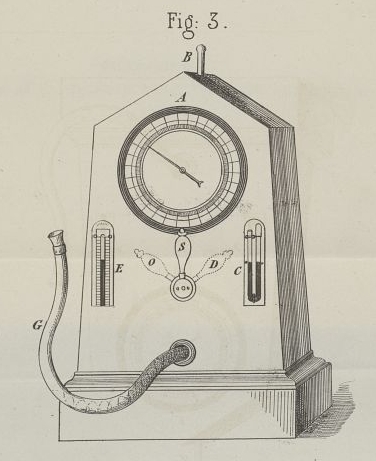
Spirometer, 1855. Described as a “dial” spirometer. It’s mode of operation was not described however appearances aside it is likely a water-seal spirometer. Legend of illustration:
A. Dial indicator of the respiratory vital capacity.
B. Movable iron rod which serves to lower the tank after each experiment.
C. Manometer.
D. Thermometer.
G. Air entry channel.
S. D.O. positions that can give the S faucet and allowing or forbidding the entry of air into the device.
Manufacturer was not named. From “Essai sur le spiromètre”, by Louis-Emile Hecht, published in Strasbourg by G. Silbermann, 1855. Found on the Medic Database.
M. B. Schnepf Spirometer, 1856. From Comptes rendus hebdomadaires des séances de l’Académie des sciences, December 1856, page 1047. “Note sur un spirometre d’une sensibilite’ et d’une simplicite’ extremes par M.B. Schnepf”.
The spirometer bell was described as 35 cm high and 18 cm in diameter, the base cylinder was described as 30 cm high and 16 cm in diameter. The breathing tube was 15 mm in diameter. Note that the chain varied in width (and therefore weight) along its length. This was designed to vary the counter weight used to suspend the bell according to its depth in the water.
Hutchinson Spirometer, 1859. From: Physiologie des Menschen. By Franciscus Cornelis Donders and Antonius Franciscus Bauduin, 1859, page 410. Essentially the same design as the original Hutchinson spirometer with some minor variations.

PFT History by Richard Johnston is licensed under a Creative Commons Attribution-NonCommercial 4.0 International License.
